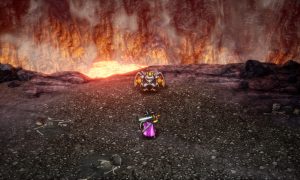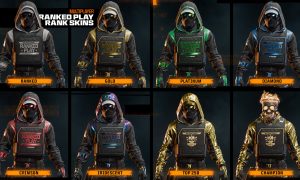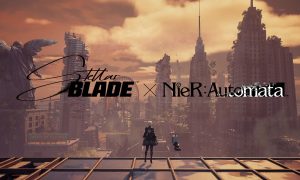Frontier Development built Elite Dangerous with over 400 billion star systems, each one having over 100+ bodies within. Every star in the sky is represented, as well as gas giants, asteroid belts, and so much more. You could land on a planet every second of your life and still not even see the the twinkling distant bodies we can see from planet Earth.
So what happens when a company so detail obsessed makes a rollercoaster game?
Normally a game in the alpha stage of development is held together with bailing wire and riddled with bugs. Planet Coaster’s first closed alpha was shockingly complete, and spelled the start of a very active engagement with the game’s community. What has emerged from that partnership is nothing short of extraordinary. Before we get into the meat of designing, maintaining, and creating a profitable park in our review of the final game, let’s talk about the tools that bring it to life. Keep your arms inside the car at all times and hold on — we’ve got a lot to talk about.
If there was a shortcoming of Rollercoaster Tycoon series it was the hex-based system for terraforming. You could raise or lower a block, add a 45 degree angle, but it all felt a little unnatural. Planet Coaster’s terrain editing engine is an absolute masterclass. Dragging or pressing into the earth like it’s so much silly putty creates mountain ranges, arches, lakes, crevices, and any other structure your mind can conjure. Creative types have even used this system to bring to life sculptures like dragons, a turtle, giant elephants, a walrus, and so much more. Beyond what you can do on the surface, you can tick a checkbox to continue your terraforming below ground. This flexibility can allow players to create multi-layer parks, underground rides, and everything in between. If you can dream it, you can build it. This is something you need to see in motion to truly appreciate. Take a moment and appreciate how much work goes into building tools that unlock this level of creativity, as well as just how easy Frontier has made creation possible.
Just as important as the terrain system is the engine for making paths. Using an incredibly flexible system, connecting your park in entirely angular, winding, or quirky interconnecting tunnels is entirely possible. You can grid-snap logical and orderly queues and walkways by checking a box and selecting a length. Unchecking that box lets you waggle the end of the path like a snake, placing it nearly anywhere you’d like. If you want to create a plaza where people might congregate and mingle (and spend money!), this recently-added and much-requested feature is now functional. To my knowledge, this is the first game to have a feature like this, and it creates an air of authenticity as every theme park in the world opens with this common space.
Having people simply wander the park somewhat aimlessly doesn’t do much for your pocketbook, however — you need them to go to rides they like and spend cash for hats and goodies while they are having fun. The AI is surprisingly good at this, as your guest insight tools will reveal. This manifests best when you take advantage of all of the various themes available in Planet Coaster.
Most parks are often split into areas with different themes. For a real world example, Disneyland has Tomorrowland with high-speed thrill rides and a science fiction flavor. They also have Frontier Land which is more western, and features a log flume, as well as a Country Bear Jamboree. For the little ones, there’s an area called Mickey’s Toontown where all of the rides are kid friendly. You can build these same sorts of park layouts in Planet Coaster with nearly a dozen themes available at launch (and likely more on the horizon), complete with mascots, pre-made themed buildings, and all of the bits and bobs to create your own.
Another cool extension of the tools engine is the selection system. Dragging a box over a large swath of your park, or even just a custom made single building, allows you to cut and paste what you’ve selected and wholesale move it somewhere else. In other games, this would have required extensive use of the bulldozer tool, but Planet Coaster makes it a snap to reconfigure your park at will.
The last major tool in the toolkit is the coaster creator itself. Snapping coasters together is a breeze — the hardest part being the selection of 27+ coaster types. Flying wing, standing, inverted, spinning, wooden, monorail, trains, and bizarre ones like the X-Dimension (here’s a real-world video of how intense that ride type really is) are just a very small sampling of the motor, chain, cable-pulled, and hydraulic launch coasters on offer here.
Once you’ve picked the type of coaster you’ll be presented with a simple interface with the next segment of track highlighted. Must like the path or terrain editor, stretching and twisting the coaster is as easy as grabbing the track and pulling it in the direction you want. Icons for pre-built loops, inversions, rolls, dead-drops, brakes, chain drive lifts, and more allow you to further customize the ride. You can even re-color the whole affair, change the number of cars per train, run multiple trains, adjust how full the ride has to be to roll, minimum and maximum wait times, and more. They are already pretty gorgeous and well-tuned, but if you want to further optimize, the tools are exposed.
One aspect of Planet Coaster I particularly enjoy tinkering with is the custom music system. You can use the pre-baked tunes, which are very catchy, or you can drop in your own custom music. I liked dropping a speed metal track behind kid rides, because it’s never too early to raise a metalhead.
If you have played previous coaster builders in the past, you’ve likely also struggled with getting track alignment and finishing your masterpiece. Planet Coaster makes this a snap with a handy auto-complete button. This is incredibly useful when putting in complex systems with rolls and inverted sections. If all of this sounds daunting, fear not — there are ten pre-built coasters that you can simply place into your environment with no effort beyond connecting the entrance and exits.
I did occasionally run into some issues with autocomplete, though the vast majority of the time it works perfectly. Sometimes, however, the autocompletion calculation will go absolutely nuts, creating the monstrosity of a monorail you see below. Thankfully, it’s infrequent and in no way impactful as you can simply undo the autocomplete, add a track section or two, and then try again — usually with positive results.
Beyond the pre-built and custom rollercoasters are five track rides like monorails, log flumes, and trains that remind me of the Disneyland Express that encircles that park. These have pre-built options or can be custom-created as well, though their parameters are far more tame requiring gentle slopes and gradual descents.
Theme parks aren’t all hands-up screaming rollercoasters, however. To attract families and folks who might not enjoy the more intense rides in your park, Planet Coaster provides merry-go-rounds, ferris wheels, teacups, pendulums, scramblers, tilt-a-whirls, drop towers, and more for a total of 27 non-coaster types (What, no Gravitron?) available at launch.
Beyond the unlimited-cash sandbox mode, a challenge and career mode awaits. Challenge mode gives you several objectives with either limited or unlimited cash to achieve them. The objectives can be a park rating, a profitability level, a certain number of guests, or even hitting a monthly profit entirely from rollercoasters. Halfway between the sandbox and career, this mode provides some external goals to tackle if you don’t want to be entirely freeform.
The Career mode reminds me of one of my favorite games of all time — Theme Hospital. With objectives similar to that of the Challenge mode, you are given a pre-built park from four themed areas — two of which you’ll have to unlock. Captain Lockjaw’s Buried Treasures, Princess Amelie’s Fairy Tale, Dex-R’s Science Shenanigans, and King Coaster’s Royal Decree all have three unlockable scenarios within their parks. This is one area that is still a review in progress as these scenarios were not available until the day before launch. If the quality of the other scenarios are any indication, I have very high hopes.
I have to point out something pretty awesome that all coaster games I’ve played have ignored. You can jump around and play the game in sandbox, career mode, or tackle challenges, but at any point you can also open any save file and convert it to a sandbox with unlimited money. It’s genius and grants a degree of flexibility to save a pre-built park from career as a starting point and then build it up from there.
There are still a few bugs in Planet Coaster. As you can see below, sometimes your guests will ignore your paths that you’ve painstakingly constructed. Similarly, sometimes guests will ignore some locations entirely and without rhyme or reason. I’ve had burger shops that were centrally located that had zero guest visits after months.
Beyond the incredible building tools to create your park lies the backend management needed to run it. Planet Coaster features a robust management system that lets you see every aspect of your park represented with numbers, charts and graphs. I’m surprised to say this, but somehow as deep as it is, it’s not enough.
Each ride comes with a whole host of stats, whether they are pre-built or custom. Excitement, how scary, and how nauseating a ride is helps you predict how many people may ride it. Various g-forces, speed, drops, sharpness and angles of turns, and more await your digestion. If you want to see it presented in a more unique way, it can also be shown with colors across the track, giving you an idea of the parts your patrons will enjoy most. Best of all, you can then ride the coaster in first or third person, seeing it from a rider’s perspective. Given that this game is built using the COBRA engine that powered Elite: Dangerous, there is a good chance we might see a VR rollercoaster mode in the future — fingers crossed.
Staff management in games like Theme Hospital was a breeze, but it is an unnecessary chore in Planet Coaster. If your staff feels like their job is too easy, they become unhappy — an issue that is only exacerbated by the bug I mentioned above. Similarly, if they feel they aren’t paid adequately, you’ll have to give them a bump or send them to training to increase their happiness. Each staff member has to be attended to individually. Similarly, you have to hire and place them individually as the menu closes every time you select one.
As your park grows, you’ll begin to put in things like ATMs, additional copies of your shops, and even duplicates of your more popular rides. The problem is that there is no tool to standardize across the park, meaning that the moment you find out that you forgot to charge for your ATMs is when you look at your profit and loss statements and see that you just lost a few hundred bucks this month on that location. While you can customize prices for individual items like hats, hamburgers, and extra addons, you’ll have to touch each and every shop individually and do all of those adjustments again. In its current state it makes creating parks fun and running them rather tedious.
The reason I mentioned how engaged Frontier has been with their community is that it has given me a high degree of confidence that the very minor issues I’ve found in Planet Coaster will be patched in short order. They could even be fixed by the time you read this. Put simply, I could write another 2000 words and not even begin to detail all of the amazing potential wrapped up in this game. We wanted a sequel to our favorite rollercoaster games, but this is so much more than a simple iteration on a theme.
A deluge of new content was just made available at launch, so stay tuned as we work through it for our full review. However, given how much I’ve already had to say, it’s pretty easy to call this review in progress a recommendation.
Ron Burke is the Editor in Chief for Gaming Trend. Currently living in Fort Worth, Texas, Ron is an old-school gamer who enjoys CRPGs, action/adventure, platformers, music games, and has recently gotten into tabletop gaming.
Ron is also a fourth degree black belt, with a Master's rank in Matsumura Seito Shōrin-ryū, Moo Duk Kwan Tang Soo Do, Universal Tang Soo Do Alliance, and International Tang Soo Do Federation. He also holds ranks in several other styles in his search to be a well-rounded fighter.
Ron has been married to Gaming Trend Editor, Laura Burke, for 28 years. They have three dogs - Pazuzu (Irish Terrier), Atë, and Calliope (both Australian Kelpie/Pit Bull mixes), and an Axolotl named Dagon!

See below for our list of partners and affiliates:



































